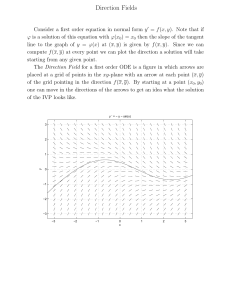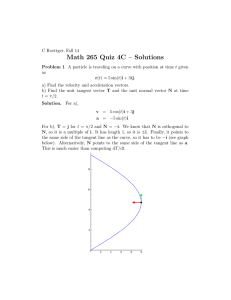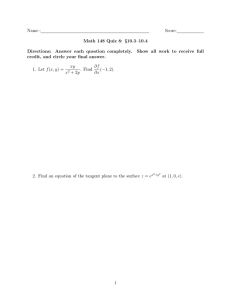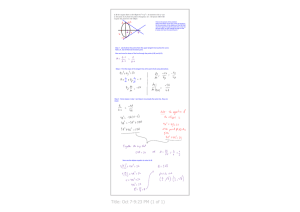Revision Notes 2 Calculus 1270 Fall 2007 INSTRUCTOR: Peter Roper
advertisement
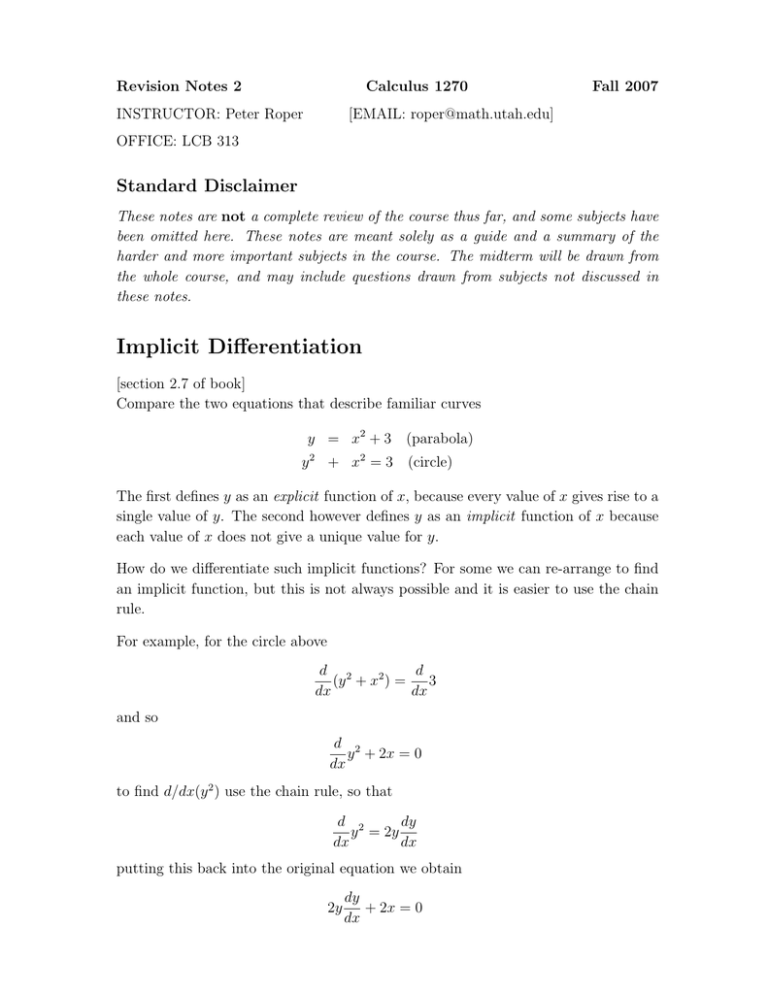
Revision Notes 2 Calculus 1270 INSTRUCTOR: Peter Roper Fall 2007 [EMAIL: roper@math.utah.edu] OFFICE: LCB 313 Standard Disclaimer These notes are not a complete review of the course thus far, and some subjects have been omitted here. These notes are meant solely as a guide and a summary of the harder and more important subjects in the course. The midterm will be drawn from the whole course, and may include questions drawn from subjects not discussed in these notes. Implicit Differentiation [section 2.7 of book] Compare the two equations that describe familiar curves y = x2 + 3 (parabola) y 2 + x2 = 3 (circle) The first defines y as an explicit function of x, because every value of x gives rise to a single value of y. The second however defines y as an implicit function of x because each value of x does not give a unique value for y. How do we differentiate such implicit functions? For some we can re-arrange to find an implicit function, but this is not always possible and it is easier to use the chain rule. For example, for the circle above d 2 d (y + x2 ) = 3 dx dx and so d 2 y + 2x = 0 dx to find d/dx(y 2 ) use the chain rule, so that dy d 2 y = 2y dx dx putting this back into the original equation we obtain 2y dy + 2x = 0 dx and we can rearrange to give dy x =− dx y which gives us an expression for dy/dx as we require. Infinitessimals/differentials and linear approximations [section 2.9 of book] Sometimes we need a quick and simple estimate of the change in a function f (x) that results when we change x slightly. If we change x by x → x + ∆x then the resulting change in y = f (x) is just ∆y = f (x + ∆x) − f (x). As shown in the figure. y y tangent line y+Dy y+dy y+Dy dy y y x x+Dx y=f(x) x Dy x x+Dx x y=f(x) However if the change is very small then we can use the tangent line as an approximation to the curve and instead find dy as an approximation to ∆y. Therefore, if the slope of the tangent line is m = f 0 (x), and using the equation (y = mx + c) for a straight line, we can write ∆y ' f 0 (x)∆x and in terms of infinitessimals, dy = f 0 (x)dx Optimization: finding maxima, minima and critical points We’ve introduced the idea of the differential of a curve at a point x0 as being the slope of the tangent line at that point. We now use this idea to examine properties of curves. We note first that if a function, f (x) has a maxima or a minima at some point, then the slope of the curve is zero AT THAT POINT because the tangent is flat. We call such a point an extrema of the function. However if there is an asymptote, the slope of the curve is infinite because it’s pointing vertically up (or down) AT THAT POINT. So, to examine the properties of the curve over some interval I, we compute it’s differential, f 0 (x) and determine whether or not the differential vanishes or goes to infinity at any point in the interval. However once we have found a point where the function has a tangent with a slope of zero, how do we tell if it’s a maximum or a minimum? Two possible ways are: • The first derivative test Compute the slope of the function on either side of the extrema. If the function is increasing on the left side (dy/dx > 0), and decreasing on the right (dy/dx < 0) then we have a maxima, if it is decreasing on the left and increasing on the right then we have a minima. • The second derivative test If the second derivative of the function f 00 (x) < 0, then we have a local maxima. If f 00 (x) > 0 then we have a local minima. Finding roots of equations numerically Often we need to find the roots, or zeros, of a function, by which I mean that we are trying to find where the function crosses the x-axis. For some functions, such as quadratic and cubics, there exist explicit formulae for computing their roots, but for most functions there is no general way of finding them. Instead we turn to approximate, or numerical, techniques. We will talk about two similar techniques, one that always converges but can be very slow, and one that is fast but doesn’t always converge. The bisection method Consider trying to find the roots of y = f (x) The point of this technique is to find two points a and b, one that is above and one that is below the root1 , and then progressively move each point, a and b, so that we narrow down the interval between them while keeping them on either side of the root. y y=f(x) a1 m1 b1 x We choose our first values for a and b, call them a1 and b1 by guessing at some numbers and then testing to see whether f (a1 ) has the opposite sign to f (b1 ) which means that they are on either side of the root. Note that if, say, f (a1 ) is positive, and f (b1 ) is negative then their product is negative too. And so to test whether they both lie on either side of the root all we need to do is calculate f (a1 ) × f (b1 ) and show that it is negative. Once we have found a suitable initial choice for a1 and b1 we can start to zoom in on the root. We first find the midpoint between a1 and b1 m1 = a1 + b1 2 and we test whether f (a1 ) × f (m1 ) or whether f (m1 ) × f (b1 ) is negative, to determine whether the root lies between a1 and m1 or between m1 and b1 . 1 Use the mean value theorem to show that the root lies between them If f (a1 ) × f (m1 ) < 0 then the root lies between a1 and m1 and so we make a new interval by setting a2 = a1 and b2 = m1 and find a new midpoint m2 = a2 + b2 2 Similarly if f (m1 ) × f (b1 ) is negative then we set a2 = m1 and b2 = b1 and again find the new midpoint. We then test m2 to find which of f (a2 ) × f (m2 ) or f (m2 ) × f (b2 ) is negative. We then continue by setting a3 and b3 equal to the resulting boundaries, and so on until we have reached a desired degree of accuracy. So, the next question is how do we decide how accurate our answer is at each iteration? This is actually pretty straightforward: at the nth iteration we’ve shown that the root lies between an and bn . This means the midpoint mn is within half of the distance between an and bn of the true root. Therefore, the quantity hn = bn − an 2 tells us how close mn is to the correct answer. This bisection method always converges to the correct answer, although it can be extremely slow. Newton’s method Newton’s method rests upon the idea that when you are close to a curve, the tangent line is a good approximation to the curve. This time we start with a single guess at the root, call it a1 . We find the next approximation, a2 to the root by finding the intersection with the x axis of the tangent line to f (x) at the point a1 , as shown in the figure. Therefore if the slope of the tangent line is f 0 (x) then the new guess is a2 = a1 − f (a1 ) f 0 (a1 ) We can then continue the iteration by finding a3 from the tangent line at a2 until we have reached the desired degree of accuracy. Newton’s method does not always converge to the correct answer, but it can be significantly faster than the bisection method. tangent line y a2 a1 x y=f(x) Differential Equations We frequently encounter problems of the form dy = f (x) dx where we have a differentiated quantity on the LHS and some function of x on the right. Such problems are called differential equations. The problem then becomes: “how do we invert the differentiation to find y as a function of x?” Simple, first order, ordinary differential equations (ODE’s) can be solved by integration, eg: ds = 10 dt is an ODE for the speed of a vehicle travelling at 10 mph, where s is the distance. Integrate to find the total distance gone from time t = 0 to t = 1 hour Z 1 0 ds = 10 Z 1dt ds = 10 dt 0 = 10t]10 = 10 miles Exponential growth and decay ODE’s that have the form dN = kN dt describe exponential growth (if k > 0) or decay (k < 0). Again solve by simple integration 1 dN = k dt Z N Z 1 dN = k dt N ln(N ) = kt + C N (t) = exp(kt + C) = exp(kt) exp(C) = K exp(kt) where, since C is a constant, K = exp(C) is also a constant. What actually is K? Think about setting t = 0, ie when the system first starts off. Then we have: N (t = 0) ≡ N (0) = K exp(k × 0) = K and so K = N (0) is the initial value for the problem. [In fact we can use the initial value of any ODE to find the constants of integration.] Separable differential equations Any ODE that can be manipulated into the form where all x’s and dx’s are one one side of the equation, while all y’s and dy’s are on the other is called a separable differential equation, and can be integrated directly. Examples dy 1 = x2 (y + 1) V dy = x2 dx dx y+1 dy 1 = (y + 1) V dy = dx dx y+1 1 dy = y 2 sin(x) V dy = sin(x) dx dx y2 and in the same way as for exponential growth, use the initial values (if given) to find numerical values for the constant of integration. Integration For the midterm I’m going to assume that you understand that integration is the ‘inverse’ of differentiation, and I’m more concerned with your being able to practically solve integrals. With this in mind, some common errors... for which you would be penalized for... are: Forgetting infinitessimals If one side of an equation is multiplied by an infinitessimal, then the other side must also be multiplied by an infinitessimal too, for example: dy = 7 sin(x) dx and so the integral becomes Z Z dy = 7 sin(x) dx and so y = −7 cos(x) + C Constants of integration When indefinite integrals (i.e. those that do not have limits) are evaluated, the solution must include a constant of integration: Z f (x)dx = F (x) + C but definite integrals (i.e. those that have limits) do not have a constant of integration Z b f (x)dx = F (b) − F (a) a Integrating f (3x), f (4x), etc This is a special case of integration by substitution. To integrate (e.g.) sin(5x) make the substitution u = 5x, so: 1 du = 5 dx or dx = du 5 and therefore Z Z sin(5x) dx = sin(u) 1 du = 5 1 = − cos(u) 5 1 = − cos(5x) 5 Integration by substitution Some integrals may be transformed to a simpler integral by substitution. When transforming an integral • Step 1 transform the variable, e.g. u = sin(x) • Step 2 transform the infinitessimal, e.g. du = cos(x)dx • Step 3 (for definite integrals) transform the limits, e.g. u1 = sin(x1 ), u2 = sin(x2 )
